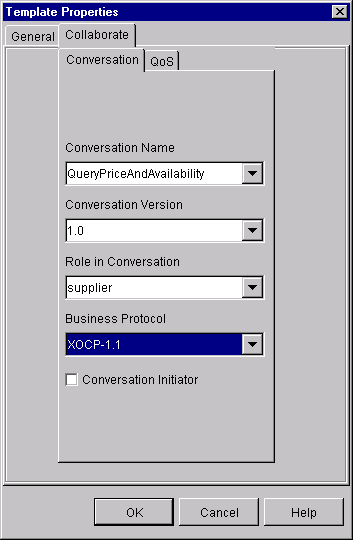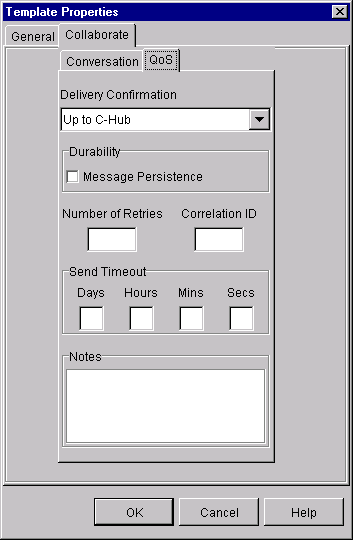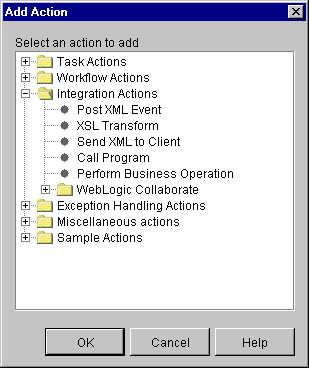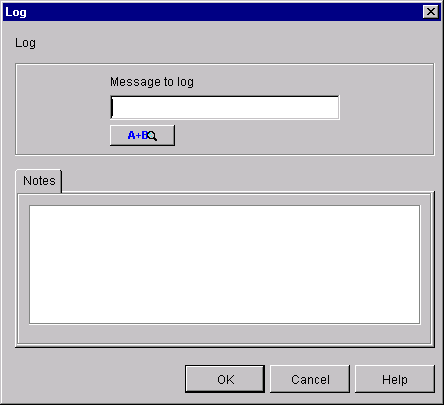


|

|
|
|
|
Defining Conversation Properties for Workflow Templates
The following sections describe how to define templates and template definitions for workflows that implement roles in WebLogic Collaborate conversation definitions:
About Using the WebLogic Collaborate Plug-In to Define Templates
To create workflows for conversation roles in BEA WebLogic Process Integrator, you use the WebLogic Collaborate plug-in to the WebLogic Process Integrator Studio. The first step in creating these workflows is defining workflow templates and template definitions for those workflows. In addition to the standard properties for templates and template definitions described in Defining and Maintaining Workflows in Using the BEA WebLogic Process Integrator Studio, you must define additional properties not described in that document that allow the workflows based on those template definitions to be used in the WebLogic Collaborate environment.
For example, suppose you link a workflow template definition to a particular role in a conversation definition and version that is bound to a collaboration agreement in the WebLogic Collaborate repository. You must also define some additional attributes, such as the protocol to which the conversation role implemented by the workflow is bound, and additional configuration data that might be required by the protocol.
For general information about defining workflow templates, see Defining and Maintaining Workflows in Using the BEA WebLogic Process Integrator Studio.
About Templates and Template Definitions
The topic Defining and Maintaining Workflows in Using the BEA WebLogic Process Integrator Studio contains a comprehensive discussion about templates and template definitions, specifically about the differences between the types of information you provide in the template and the template definition.
The only data required in a template definition that you cannot define in a template is the expiration date and whether the template definition is active. However, it is good practice to set all conversation properties in the template, such as the following:
Then, when you create a template definition, you have the flexibility of overriding any conversation properties defined in the template, as appropriate. However, the primary advantage to assigning these properties in the template instead of the template definition is that you can specify properties for all template definitions contained in a given template.
Notes: Due to a limitation in WebLogic Process Integrator, template properties are not exported when you export a template definition. That is, the properties that a template definition inherits from a template are not exported. You should consider your export requirements when you determine the properties to define in a template versus a template definition.
Template definition properties are exportable, but are specific to only one template definition.
The sections that follow show how to define conversation properties in the template; however, it is possible to define all these properties in the template definition, instead.
Creating a Workflow Template
To create a workflow template in the WebLogic Process Integrator Studio using the WebLogic Collaborate plug-in, complete the following steps:
Figure 2-1 Template Properties Dialog Box

Linking Templates to Conversations
Before you use a WebLogic Process Integrator workflow to exchange business messages in BEA WebLogic Process Integrator, you must first link the workflow template to a particular conversation definition (a conversation name, version, role, and protocol) in the BEA WebLogic Process Integrator repository.
To link a workflow template to a conversation definition:
Figure 2-2 Collaborate Page

Linking Templates to Collaboration Protocols
In general, linking a template to a specific protocol affects what you see in many of the WebLogic Collaborate plug-in dialog boxes and tabs throughout the Studio. As this document explains how to use various components of the WebLogic Collaborate plug-in to perform various tasks, such as defining workflow start properties, sending and receiving business messages, and terminating conversations, you will see how the appearance of each plug-in component varies, depending on the protocol chosen for the workflow template.
For example, Table 2-1 explains that if you choose the XOCP protocol while configuring a workflow template, an additional tab is displayed in which you can specify Quality of Service (QoS) settings for business messages exchanged in workflows based on that template.
With respect to linking a template to a protocol, do the following:
Defining the Quality of Service for XOCP Message Delivery in the Workflow Template
The Quality of Service (QoS) is a set of attributes that are defined for reliable business message publishing. You can set QoS attributes only for business messages sent via the XOCP protocol.
In WebLogic Process Integrator, you can define the QoS in the following:
To specify the Quality of Service in the workflow template:
Figure 2-3 Quality of Service Properties Page

Logging Messages
The WebLogic Collaborate plug-in to the Studio provides a means to send messages— for example, debug messages, run-time information, or application messages—to the WebLogic Collaborate log at any point during the execution of a collaborative workflow. This functionality is provided via the Log action, which you can add to any node in the workflow. This action can provide a useful debugging tool during the workflow design process.
To add a Log action to a node in the workflow, complete the following steps:
Figure 2-4 Add Action Dialog Box
Figure 2-5 Add Action Dialog Box with Workflow Actions
Figure 2-6 Log Action Dialog Box

About Working with WebLogic Process Integrator Variables for Workflows
A WebLogic Process Integrator variable is typically used to store application-specific information required by the workflow at run time. Variables are created and assigned values largely to control the logical path through a workflow instance. The same workflow template definition is instantiated multiple times and can be traversed in different ways if the flow contains decision nodes.
The guidelines for working with variables that apply to noncollaborative workflows also apply to collaborative workflows. (They are fully explained in Using the BEA WebLogic Process Integrator Studio.) When creating workflows, keep the following guidelines in mind:
Note: Applications that start workflows programmatically must use the WebLogic Process Integrator Integration API. For more information, see Developing Applications that Start Conversation Initiator Workflows.
Associations Between WebLogic Process Integrator Variables and Java Data Types
If you want to access a WebLogic Process Integrator variable within a business operation, you need to know how WebLogic Process Integrator variable types correspond to Java data types. The following table shows how they are related.
Rules for Defining WebLogic Process Integrator Variables
The rules for defining WebLogic Process Integrator variables for collaborative workflows are the same as those for WebLogic Process Integrator workflows:
Note that the variables that specify binary attachments to a business message must contain a source file or destination file, as appropriate.
Defining Variables
For complete details about defining WebLogic Process Integrator variables in the Studio, see Working with Workflow Components in Using the BEA WebLogic Process Integrator Studio.

|

|

|
|
|
|
Copyright © 2001 BEA Systems, Inc. All rights reserved.
|